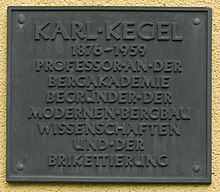Karl Kegel
Friedrich Karl Kegel (born May 19, 1876 in Magdeburg , † March 5, 1959 in Freiberg ) was a German mining engineer .
Life
Karl Kegel was born in Magdeburg in 1876 as the son of a shift foreman. In 1893 he finished secondary school, after which he worked as a miner in Staßfurt for a year . After his military service, he gained practical experience in various mining districts, so that, with good previous knowledge, he was able to attend the mountain school in Eisleben from 1896 to 1898 .
After graduating, Karl Kegel found work in lignite mining. However , in 1901 he gave up his post as a steiger at the Rositzer lignite factory in order to take up university studies in Berlin . There he became a member of the Corps Holsatia at the beginning of his studies .
As a student he was already very interested in briquetting . His first publication (published in the magazine Glückauf in 1902 ) was entitled: The Origin of Brown Coal Briquettes . In 1904 he graduated from the Bergakademie Berlin as a qualified mining engineer .
After a short time as an assistant at the Bergakademie Berlin and a one-year activity as a mining inspector in the Halleschen Pfänständigership, he started working as a teacher at the Bergschule Bochum in 1906. In addition to numerous articles in specialist journals, he published his first monograph in 1912 : Mining Water Management .
In 1918, Karl Kegel was appointed professor for mining, mining and briquetting at the Freiberg Mining Academy. From 1924 he headed the mining technology department of the lignite research institute. In November 1933 he signed the German professors' confession of Adolf Hitler . His lectures covered a wide spectrum, including a. Lignite and hard coal mining, deep drilling, groundwater science, briquetting, processing and mining economics. Among other things, he published the textbook for mining economics (1931) and mining mechanics (1941).
He was retired in 1941 but returned to his institute in 1945. In 1951 he handed over his office to his student Erich Rammler due to health problems . Kegel researched and published further and wrote, among other things, his textbook on brown coal opencast mining in 1953 . In 1949 he was accepted as a full member of the Saxon Academy of Sciences and the German Academy of Sciences in Berlin . He was a member of the Freemason's lodge "To the three mountains".
Karl Kegel died in Freiberg in 1959 and was buried in the Donatsfriedhof . Karl-Kegel-Straße in Freiberg is named after him.
Awards (selection)
- 1949: Honorary citizen of the city of Freiberg
- 1949: National Prize of the GDR
- 1952: Honorary doctorate from RWTH Aachen
- 1956: Great Scientist of the People
literature
- Evelyn Kroker : Kegel, Karl. In: New German Biography (NDB). Volume 11, Duncker & Humblot, Berlin 1977, ISBN 3-428-00192-3 , p. 394 ( digitized version ).
- Erich Rammler: Karl Kegel . In: Glückauf . 95/1959, pp. 1235-1236
- Karl Kegel 1876–1959: Festschrift on the occasion of his 100th birthday . German publishing house for basic industry, Leipzig 1976. - (Freiberg research books; A 555)
- Lignite in research and teaching at the Bergakademie Freiberg, ed. on the occasion of the 125th birthday of Prof. Dr. eh Karl Kegel on May 19, 2001 . TU Bergakademie Freiberg, 2001. ISBN 3-86012-142-1
- Association Freiberger Geotechniker eV (Ed.): Geotechnics in Freiberg from the beginnings under Franz Kögler and Karl Kegel to the present . TU Bergakademie Freiberg, 2016. ISBN 978-3-86012-527-4
Web links
- Literature by and about Karl Kegel in the catalog of the German National Library
- Literature by and about Karl Kegel in the Saxon Bibliography
Individual evidence
- ↑ Erwin Willmann (Ed.): Directory of the old Rudolstädter Corps students. (AH. List of the RSC.) , 1928 edition, No. 2243
| personal data | |
|---|---|
| SURNAME | Kegel, Karl |
| ALTERNATIVE NAMES | Kegel, Friedrich Karl |
| BRIEF DESCRIPTION | German mining engineer |
| DATE OF BIRTH | May 19, 1876 |
| PLACE OF BIRTH | Magdeburg |
| DATE OF DEATH | March 5, 1959 |
| Place of death | Freiberg |


